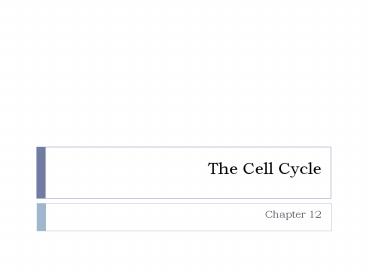The Cell Cycle - PowerPoint PPT Presentation
1 / 26
Title:
The Cell Cycle
Description:
The Cell Cycle Chapter 12 When do cells divide? Reproduction Replacement of damaged cells Growth of new cells In replacement and growth cell divisions, how should ... – PowerPoint PPT presentation
Number of Views:60
Avg rating:3.0/5.0
Title: The Cell Cycle
1
The Cell Cycle
- Chapter 12
2
When do cells divide?
- Reproduction
- Replacement of damaged cells
- Growth of new cells
- In replacement and growth cell divisions, how
should daughter cells compare to parent cell? - The daughter cells should be identical copies of
the parent cell
3
Functions of Cell Division
4
How can identical daughter cells form?
- The genome must be copied and then divided such
that each daughter cell gets one of the copies. - Genome all the genes in an organism
5
Bacterial Reproduction
- How do bacterial
- cells reproduce?
6
Important terms in eukaryotic cell division
- Chromosome - threadlike structures that are
composed of DNA and protein - Replication - process whereby DNA is identically
copied (before cell division) - Mitosis - division of the nucleus
- Cytokinesis - division of the cytoplasm
- Chromatin - DNA and protein complex that is thin
and fibrous it will condense into distinct
chromosomes during cell division
7
Important terms in eukaryotic cell division
- Chromatid - after replication the chromosome
consists of 2 sister chromatids joined at the
centromere - Centromere - specialized region of the
chromosome, where chromatids are joined. Each
chromosome has one centromere
8
The Cell Cycle
9
Interphase
- 90 of cell cycle is spent in this phase
- G1 first growth phase
- S synthesis phase, DNA synthesis (replication)
occurs here - G2 second growth phase
10
G2 phase of Interphase in animal cells
- Nuclear envelope is visible
- One or more nucleoli are present
- Centrioles are replicated and the 2 pairs are
near nucleus - Aster forms around each pair of centrioles
- Chromosomes are loosely packed into chromatin
fiber, not distinguishable
11
General Overview of Mitosis
12
Prophase
- In the Nucleus
- Nucleoli disappear
- Chromosome fibers condense into discrete
chromosomes - Each chromosome consists of 2 sister chromatids
joined at the centromere
13
- In the Cytoplasm
- Mitotic spindle begins to form
- Spindle consists of microtubules arranged between
the centrosomes - Centrosomes move apart due to lengthening of
microtubules
14
Prometaphase
- Nuclear envelope breaks apart
- Each chromatid has specialized structure called
kinetochore located at the centromere region - Kinetochore microtubules interact with
chromosomes at the kinetochore region - The kinetochore microtubles cause the chromosomes
to move - Nonkinetochore microtubules radiate from each pole
15
Metaphase
- Chromosomes move to the metaphase plate and line
up there - The centromeres of the chromosomes are all
aligned on the metaphase plate - Each sister chromatid of one chromosome, has a
kinetochore microtubule attached to it from
opposite poles - Kinetochore microtubules nonkinetochore
microtubules spindle fiber
16
Anaphase
- Kinetochore microtubules shorten and
non-kinetochore microtubules lengthen - Centromeres divide and each chromosome has no
sister chromatid component - The shape of the cell elongates into an ellipse
- Chromosomes are pulled to the opposite poles
17
Telophase
- Nonkinetochore microtubules continue to elongate
the cell - New daughter nuclei form at the two poles
- New nuclear envelopes are formed around the
chromosomes - Nucleoli reappear
- Chromosomes uncoil into chromatin fiber
- Last phase of mitosis
18
Cytokinesis
- Begins before telophase has completed
- Evidenced by cleavage furrow in animal cells and
cell plate in plant cells
19
(No Transcript)
20
(No Transcript)
21
Evolution of mitosis
Bacterial cells
Dinoflagelates chromosomes attach to nuclear
envelope.
22
Diatoms nuclear envelope stays, microtubules
inside nucleus
Most other eukaryotes spindle forms outside of
nucleus, and nuclear envelope breaks apart
23
Cytoplasmic Cell Signals in Regulation of Cell
Cycle
24
Checkpoints in the cell cycle If it passes the
G1 checkpoint cell divides -if not, enters G0
phase and does not divide
25
Cyclin protein levels fluctuate according to cell
cycle stage. When cyclin is high the Cdk
attaches and phosphorylation leads to breakdown
of nuclear envelope. Later MPF initiates cyclin
breakdown
26
Cancer cells
- How does abnormal cell division of cancer cells
differ from normal cell division? - Cancer cells are not under density dependent
inhibition - Continue to grow until all nutrients are used up
- Cancer cells are immortal, do not shorten
telomeres































